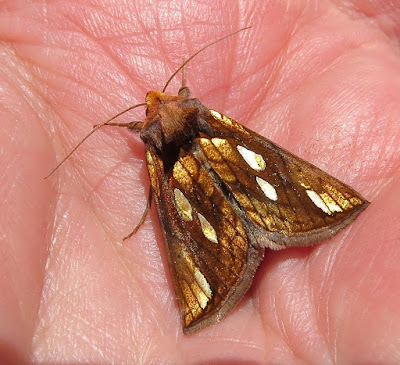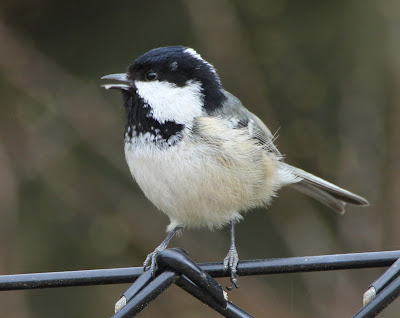The air temperature at ‘lighting up time' on Saturday (21:30),
yes we’ve fallen behind a little,
was a whacking +28°C and as dawn cracked, it
still hadn’t dropped below +18°C. Anticipation of the Moth Traps rounds was
heavy in the air but didn’t result in the expected glut!
The resultant First for Year Moths included
GOLD SPOT
always 'great' to see the first iof these little beauties.
TWIN-SPOTTED WAINSCOT
a little duller while duller still is
CURRENT PUG
but they all count!
Additionally,
DEVIL'S COACH
HORSE BEETLE
serenaded by the only 'vocal'
COAL TIT
to have been heard in the garden.
Pleasant enough just watching this
GREENFINCH
catching the first rays of the new day while just a little further north
the first
REED BUNTING
which is the firt one noted since the small influx
of early Spring which could well be the next usually
Breeding Species
to abandon the Recording Area?
HEATHER
is starting to look good even though a little backward by comparison woth 2019
but still some way to go and as far as other plant-life is concerned
The Fern is as high as a Galloway's eye and
it looks like its climbing clear up to the sky!
All we need now is a catchy tune and we may well go speeding up the charts??
Both species of
BANDED DEMOISELLE
(female) and
(male)
along with
male
BEAUTIFUL DEMEOSELLE
female
were on the wing and looks every bit like the latest to meet its
Waterloo is
WOOD PIGEON
Black-winged Stilts breed
in Somerset
A pair of Black-winged Stilts has successfully
hatched two chicks at WWT Steart Marshes for the very first time – the
only known breeding of the species in Britain this summer. The waders have
settled in a secluded area of the wetlands, building their nest on a small
island of mud within the freshwater area to deter predators. The chicks hatched
yesterday [Thursday 9 July] and will be attended to by their parents until they
fledge.
This is the only known pair of stilts to have staged in the UK
this year. Previous breeding efforts have generally only taken place in
south-east England - indeed, it is thought that this is the furthest west
Black-winged Stilt have ever nested.
Alys Laver, Site Manager at WWT Steart, welcomed the news. She
said: "We were thrilled to discover a pair of rare Black-winged Stilts
nesting by the muddy areas in the freshwater marsh. They are very unusual
visitors to this side of the country and it shows how valuable this developing
marsh is to waders.
"By acutely managing water levels throughout the year, we
can make sure that the mud is moist and teeming with juicy invertebrates for
the birds to feast on with those large, pointy beaks, as well as help to
protect the nest. It's all about getting the swamp community just right.
"The Steart Marshes are just six years old, and it goes to
show how quickly new wetlands can support amazing wildlife. If you create it,
they will come!"
The birds have picked a sheltered part of the reserve which is
fenced off, surrounded by deep water with plenty of cover overhead from wetland
plants. Reserve staff have also covered posts with bird deterrents close to the
nest to help stop predators potentially targeting their young. In 2014, a
clutch hatched in North Kent, 30 years after the previous British breeding
attempt. Then, in 2017, 13 stilts are known to have fledged in southern England.
Alys continued: "It's early days and we don't want to
get ahead of ourselves. However these birds are faithful to their breeding
sites, so who knows, one day we might have a small population at Steart. In the
meantime we’ll be doing all we can to make sure Steart is an attractive a home
as possible for this striking water-bird as well as other wetland animals.
We thank John Gifford for passing on this intersting document.





















No comments:
Post a Comment